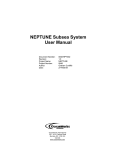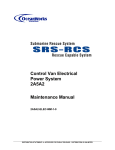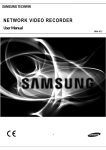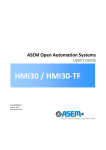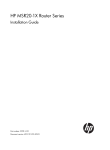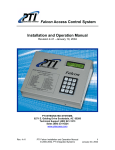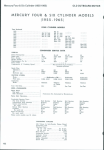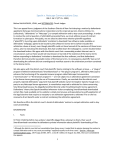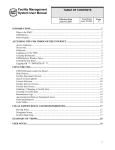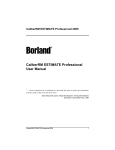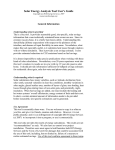Download User Guide - Venus - University of Victoria
Transcript
Victoria Experimental Network Under the Sea User Guide Version 1.9 7 May 2010 Document Control Sheet Contact for Revisions and Proposed Changes Adrian Round [email protected] Record of Issues Issue Date 1.0 1.1 1.2 1.3 1.4 1.5 1.6 1.7 1.8 1.9 03/12/2003 31/03/2005 27/05/2005 24/08/2005 26/09/2005 15/04/2006 05/05/2006 24/05/2006 11/03/2008 7/05/2010 Document Status Draft for discussion Update based on Saanich Inlet design Updates based on document review Updates based on design changes Updates based on design changes Updated with comments from JV, RY, RD and PM Updates and edits by RD Edits by PM Edits by PM Edits by FM 2 Table of Contents VENUS Acronyms/Glossary .......................................................................................................... 5 Acronyms ....................................................................................................................................5 Glossary.......................................................................................................................................5 Section 1 - Introduction .................................................................................................................. 7 1.1 Document Purpose ...............................................................................................................7 1.2 VENUS Description.............................................................................................................7 Section 2 – Accessing VENUS Data .............................................................................................. 7 2.1 Overview..............................................................................................................................7 2.2 Access to VENUS data ........................................................................................................8 2.3 QA/QC: Data validation and archiving of processed results ...............................................9 2.4 Links to other data archives .................................................................................................9 Section 3 - Incorporating VENUS into your Proposal/Research.................................................... 9 3.1 Research Opportunities on VENUS.....................................................................................9 3.2 Accessing VENUS Infrastructure ......................................................................................10 3.3 Contacting VENUS (First Stages of Application Process)................................................13 Section 4 - Designing a VENUS Compatible Scientific Instrument Package .............................. 14 4.1 Overview............................................................................................................................14 4.2 Physical Interface...............................................................................................................14 4.3 Electrical Interface .............................................................................................................16 4.4 Communication Protocols..................................................................................................16 4.5 Environmental Considerations and Restrictions................................................................17 Section 5 - Deploying Your Scientific Instrument Package on VENUS...................................... 18 5.1 Connection Options ...........................................................................................................18 5.2 Pre-deployment Testing .....................................................................................................18 5.3 Science Package Deployment ............................................................................................18 5.4 Instrument Servicing..........................................................................................................19 5.5 PI Responsibilities With Respect to Data QA/QC.............................................................19 Section 6 – Policy Guide............................................................................................................... 20 6.1 Overview............................................................................................................................20 6.2 Access Priority ...................................................................................................................20 6.3 Facility Research Instrument Control ................................................................................20 6.4 Instrument Failures ............................................................................................................20 6.5 Conflict Resolution ............................................................................................................21 6.6 Liability..............................................................................................................................21 6.7 Security Issues ...................................................................................................................22 6.8 Privacy Policy ....................................................................................................................22 Appendix 1 - VENUS Facility Research Instruments .................................................................. 23 A1.1 Facility Research Instrument Overview ........................................................................23 A1.2 Facility Research Instrument Packages .........................................................................23 Appendix 2 - VENUS Science Node/SIIM Interfaces.................................................................. 24 Node Port Configuration ...........................................................................................................24 SIIM Port Configuration ...........................................................................................................24 Appendix 3 – ROV Compatibility Requirements......................................................................... 27 3 Appendix 4 - VENUS User Forms .............................................................................................. 28 Appendix 5 - VENUS Scientific Package Deployment Checklist................................................ 32 4 VENUS Acronyms/Glossary Acronyms ADCP - Acoustic Doppler Current Profiler ADV - Acoustic Doppler Velocimeter CTD - Conductivity, Temperature, and Depth instrument DMAS - Data Management and Archiving System GTD - Gas Tension Device NOC - Network Operations Centre SIIM - Scientific Instrument Interface Module VENUS - Victoria Experimental Network Under the Sea VCP - VENUS Camera Platform VIP - VENUS Instrument Platform Glossary Array - One completed cabled system from seafloor instruments to shore station. VENUS consists of two separate arrays. Event - In this document, “event” refers to some condition of scientific interest detected in the data stream. Facility Research Instrument - An instrument funded by the VENUS Facility whose data is available to the scientific community. For-profit User - A for-profit user is an individual or organization that is deploying a scientific instrument package for commercial purposes. Meta-Data - Data which describes other data. Meta-data can be a recursive concept where the meta-data is further described by other meta-data. Near-Real-Time - Response time to stimuli or events is set at a preferred level, but failure to meet the response time is acceptable. Network Operations Centre - The NOC is the physical site where control over the VENUS facility takes place. Principal Investigator - A principal investigator is a researcher who has been granted special privileges to use the VENUS system. Registered User - A registered user is a researcher who has registered to use the VENUS system. Public User - A public user is a user who has no special privileges to use the VENUS system, but is free to view the generated data products. Science Oversight Committee - Membership constituted from the user community; mandate to advise VENUS Operations on Facility configuration in response to user needs and to resolve conflicts among user requests. Scientific Instrument Package - One or more scientific instruments connected to a VENUS Node. Scientific Instrument Interface Module (SIIM) - The SIIM is standard VENUS hardware for instrument multiplexing. The SIIM has 4 serial (RS-232, RS-422, RS-485) and 2 Ethernet (10/100 BaseT) ports, each providing 24Vdc for instrument power. 5 Shore Station - A site at or near the cable landings of the individual VENUS arrays. This site houses equipment supplying power and communications to and from the VENUS arrays. VENUS Science Node - A VENUS Science Node is an underwater structure that houses power and communications equipment and provides the physical connections between the fibre optic cable and the scientific instrument packages. VENUS Science Node Port - a wet-mateable connector at the Node available for powering and communicating with SIIMs and scientific instrument packages. The connector provides 10/100 BaseT Ethernet communications and 360 Vdc. VENUS Website - http://www.venus.uvic.ca VENUS Camera Platform (VCP) - The VCP is a two part structure for housing a digital stills camera and associated instruments. The main cradle hosts the SIIM and instruments, with a removable tripod supporting the camera system. VENUS Instrument Platform (VIP) - The VIP is a structure for housing instruments near the seabed. This platform was designed to accommodate a host of oceanographic sensors, and a VENUS SIIM(S). 6 Section 1 - Introduction 1.1 Document Purpose 1.1.1 VENUS exists to serve its users. Our vision is a user group consisting primarily of individual research scientists, but including government agencies, private companies, non-profit groups, for-profit entities, and the general public. This document seeks to lower participation barriers and to define the respective responsibilities of both the Facility and the end user. The purpose of this document is to inform all users on: 1. the VENUS Facility 2. how to access data and other facility resources 3. the process for connecting a scientific instrument package to the system The Users Guide assumes a general understanding of the overall VENUS Facility. 1.1.2 This document will evolve as the infrastructure grows and interaction with users matures. VENUS operators welcome suggestions for modifications. 1.2 VENUS Description 1.2.1 A Facility overview describing the technical aspects of the system can be found at http://www.venus.uvic.ca/discover-venus/what-is-venus. The status of the arrays and the location of the Science Nodes and scientific instrument packages are also posted on the website http://www.venus.uvic.ca/notice-to-mariners and http://www.venus.uvic.ca/system-status. 1.2.2 VENUS strives to offer connectors, power and communication protocols compatible with NEPTUNE and MARS observatories. As one of our roles is to offer “test-bed” services, we encourage users to try their instruments on VENUS where deployment and recovery is less complex. NEPTUNE Canada The VENUS Science Node Port connectors are “pin for pin” compatible with the NEPTUNE Canada Science Node Ports. MARS The VENUS Science Node Port connectors are “pin for pin” compatible with the MARS Science Node Ports with the exception that the VENUS Science Node Ports do not provide 48Vdc on pins 11 and 12. Section 2 – Accessing VENUS Data 2.1 Overview 2.1.1 Access to the VENUS data stream and archive is controlled by the Data Management and Archive System (DMAS). All data flowing from the scientific instrument packages must pass through the DMAS. Using a web browser based interface, users can access current data and 7 search the data archive at http://www.venus.uvic.ca/data/data-plots. Direct interaction with scientific instrument packages (i.e. controlling the digital camera) is accomplished using Virtual Private Network (VPN) access to authorized users. In all cases, access and use of the VENUS data is governed by the Data Policy (http://www.venus.uvic.ca/wpcontent/uploads/VENUS_Data_Policy.pdf). 2.1.2 The VENUS Facility provides near real-time access to the data streams from the scientific instrument packages. Post collection processing in the DMAS may introduce delays in the availability of certain data streams. These delays are instrument specific and can range from seconds to days. Specific questions on the delays associated with specific instruments should be directed to VENUS Operations staff. 2.2 Access to VENUS data 2.2.1 Access to VENUS data is based on the “user” requesting the data. There are four categories of user: 1) General public users. Members of the general public have access to selected data streams and certain automatically generated data products (plots) posted on the website. These data streams are freely available and there is no cost associated with them; 2) Registered users. Registered users have access to the raw data streams from the community science experiments and have the ability to search the DMAS. Access to the DMAS is through the VENUS website. Depending on the current status of facility funding, a user fee may be charged for downloading data. Consult the latest version of the User Fee document http://www.venus.uvic.ca/research; 3) Principal Investigators. Principal Investigators have access to the data streams from their scientific instrument packages and from community science experiments, and have the ability to search the DMAS. Expenses associated with deploying a scientific instrument package and accessing the data stream are detailed in the latest version of the User Fee document http://www.venus.uvic.ca/research; and 4) For-profit users. For profit users have access to the data streams from their instrument packages and from community science experiments, and have the ability to search the DMAS. There is a cost associated with deploying an instrument package on VENUS is detailed in the latest version of the User Fee document http://www.venus.uvic.ca/research, and there is a cost associated with the commercial use of VENUS data streams. 2.2.2 Users may register with the VENUS Facility via the website. PIs and for-profit users should apply to the VENUS Facility following the steps outlined in Section 3. The VENUS Facility reserves the right to refuse access to the system and/or the data archive. Inappropriate access to the facilities may result in a revocation of privileges. 8 2.2.3 Principal Investigators are requested to provide a subset or summary of their data to general and registered users (see section 5.5). This information serves two purposes: it allows the public and potential users to see the type of data collected and part of the story emerging; and secondly, interested scientists can contact the PI to discuss possible collaborations. 2.2.4 Data and data products (i.e. plots) available through the website and DMAS tools may vary depending on the type of data and the category of user. Data galleries available to all users on the website display recent data (i.e. last 24 hours) in high/full resolution, and longer term trends (week/month/year) from sub-sampled/processed data. Image, acoustic, and profile data gallery products may be available to all users in a reduced resolution. Full/raw data values maybe requested through user access to the DMAS search tools. 2.3 QA/QC: Data validation and archiving of processed results 2.3.1 The utility of the data archive depends on having quality data, quality metadata, and linkages to processed results. The responsibility for data validation varies by instrument. 2.3.2 The VENUS Facility will maintain a “Data Quality Assurance and Quality Control Plan” that outlines the intent, criteria, procedures, and recording methods for upholding an archive of high quality and defendable data. 2.3.3 Users who create processed results, make discoveries, and/or publish research from VENUS data are requested to report these results to the VENUS Facility. Where appropriate, users will be asked to provide links to the results for inclusion in the archive/website. When requested, confidentiality will be honoured, although statistics of the number and type of results will be maintained for agency review. 2.4 Links to other data archives 2.4.1 The DMAS has the ability to link to other data archives. A current list of linked databases and any restrictions associated with these databases can be found on the website (http://www.venus.uvic.ca/). Section 3 - Incorporating VENUS into your Proposal/Research 3.1 Research Opportunities on VENUS 3.1.1 The VENUS Facility is a community resource funded primarily by government grants. Its primary purpose is to serve scientific research; however, further applications that involve environmental monitoring, public education, and commercial interests are also invited. Our funding mandate supports priority access by Canadian researchers but we do not expect this will limit access by others. Any user may participate with the VENUS Facility: 9 1) By downloading the Facility Research Instrument data and/or data products; 2) By suggesting instrument configuration changes; or 3) Through the installation of user-specific instrumentation systems. No affiliation with the University of Victoria, the principal operator of the VENUS Facility, is necessary to be an active participant. Facility operating costs are offset by government grants to the University and through user fees. The fee structure is based on facility operating grant level, user affiliation, and anticipated data use. The most recent User Fee document can be found here http://www.venus.uvic.ca/research. The facility reserves the right to alter the fee structure. 3.1.2 The infrastructure is a facility only and does not grant funds for research. The VENUS Facility Office may have information on how to access other grants to initiate research. The Office will undertake to provide information on past, current, and planned studies such that collaborative interactions among researchers may develop. 3.2 Accessing VENUS Infrastructure 3.2.1 The VENUS Facility involves two general classes of instruments: “Facility Research Instruments” and “Investigator Instruments”. Facility Research Instruments are funded through the VENUS Facility. Facility Research Instrument data and certain data products are not restricted. A detailed list of the VENUS Facility Research Instruments can be found here http://www.venus.uvic.ca/discover-venus/what-is-venus/instruments and http://www.venus.uvic.ca/discover-venus/what-is-venus/instruments/instrument-locations-andtimelines. Investigator Instruments are funded independently from the VENUS Facility infrastructure. Data generated by these instruments may have restrictions (for a prescribed time) in accordance with the VENUS Data Policy. Interested users are encouraged to contact the Principal Investigator for that instrument to gain access to data. PIs, however, will be required to provide data summary products from Investigator Instruments (see section 5.5). 3.2.2 The VENUS Facility aspires to accommodate the needs of many ocean instruments, both off-the-shelf and user-built. Evaluation prior to deployment is required to determine any potential interference issues among instruments on the VENUS Facility; one area of concern is electrical and acoustic noise. All investigators interested in deploying apparatus on the VENUS Facility must submit relevant technical specifications to the VENUS Office to allow for evaluation of compatibility and to assist the investigator in fulfilling their requirements. 3.2.3 The VENUS Facility has several infrastructure platforms on which to mount additional instruments: VENUS Instrument Platforms (VIP), and the VENUS Camera Platform (VCP). The VIP has been designed to accommodate a variety of existing and future ocean sensors. 10 Figure 1: VENUS Instrument Platform (VIP) Figure 2 - VENUS Camera Platform (VCP) 11 Figure 3 - VENUS Sediment Dynamics Laboratory Location of the facility packages were chosen by consensus among initial VENUS researchers. There are two options for deploying instruments in other locations: 1) apply to have the relevant community package moved (see Appendix 4-3); and 2) supply an instrument on an “extension” cable that connects to the Node. Deployment of scientific packages in excess of 70 meters from the Science Nodes will require a custom extension cable (see paragraph 4.3.3). 3.2.4 Once installed, instrument command and data retrieval are accomplished via “instrument drivers” developed in collaboration with the Data Management and Archive System (DMAS). The VENUS Network Operation Centre (NOC) will confirm instrument connection and activation. Where applicable, the NOC may execute a series of system and instrument checks, and will maintain a continuous log of system status (i.e. voltage and current) for each instrument. Data transmitted from an instrument will be buffered at the array shore station, and transmitted to the DMAS servers. Once received and archived, users can access data using search tools on the VENUS webpage. 12 3.3 Contacting VENUS (First Stages of Application Process) 3.3.1 The VENUS website (http://www.venus.uvic.ca/about-u) provides a list of facility personnel and other contacts, in addition to information about on-going projects. The facility will also keep a list of investigator contacts. 3.3.2 The initial steps to exploring an experiment on VENUS include the following: 1) Decide if your interest is to use data currently provided, to reconfigure Facility Research Instruments currently in operation, and/or to attach a new instrument to the array; 2) Contact the VENUS Associate Director Research or Project Engineer to discuss possible integration with current studies; 3) If you have to obtain research funding, a paragraph describing the VENUS Facility for inclusion in your proposal is available at http://www.venus.uvic.ca/discover-venus/what-is-venus. After discussing your participation on the VENUS Facility with the Associate Director Research, a “letter of support” can be provided. The VENUS Facility Office reserves the right to decline a proposal on reasonable grounds such as instrument incompatibility or environmental concerns; 4) Potential participants need to submit a “VENUS Scientific Instrument Package Installation Request Form” (Appendix 4). This information allows us to determine observatory compatibility and whether additional testing will be necessary; Certain commercial instruments may be “pre-qualified”; 5) If your instrument involves active or passive acoustics, submit the “VENUS Acoustic User Information Form” (Appendix 4), including frequency and bandwidth specifications. Potential acoustic interference among experiments will be evaluated. This information is also needed to make a preliminary assessment of potential concerns to military operations; 6) The VENUS Facility Office will examine power management and communication demands on the arrays and will assess potential interference issues between scientific experiments; 7) You may be contacted for information on environmental effects or impacts related to your experiment; be aware that liability for adverse effects from an investigators instrument lies with that investigator. See Section 4.5; and 8) The VENUS Facility Office holds permits for seafloor installations; in some cases, an addendum to the permit may be required when further instrumentation is added. You will be contacted in the event that further information is required. 13 3.3.3 The participant who wishes access to all community data must register via the “Data Search” links on the VENUS website; a fee may be applicable depending upon data use (see the latest version of the User Fee document http://www.venus.uvic.ca/research). Directions for registration are available on the website (http://www.venus.uvic.ca/data/data-archive). Information requested during registration is for internal use only. However, we hope to stimulate collaborative investigations and PIs may be asked to both post preliminary results and make themselves accessible to other researchers. See section 6.8 Privacy Policy. 3.3.4 The participant who proposes reconfiguration of Facility Research Instruments should contact the Facility office to discuss the consent procedure. See VENUS Facility Research Instrument Modification Request Form in Appendix 4. Conflicts will be resolved by the Science Oversight Committee. 3.3.5 For information on how to configure your instrument for VENUS deployment see Section 5. Once your experiment is prepared, the VENUS Facility Office will provide you with information on scheduling for the testing and deployment of your instrument(s). Section 4 - Designing a VENUS Compatible Scientific Instrument Package 4.1 Overview 4.1.1 Your scientific instrument package must comply with the physical and electrical interface specifications of the VENUS network. Strict compliance with the specifications will help ensure that your instrument functions properly when plugged in to the VENUS infrastructure. 4.2 Physical Interface 4.2.1 The physical interface includes the following areas: 1) The physical size of the scientific package, including the bottom footprint and the vertical extent of the sensors into the water column; 2) ROV compatibility (if required); and 3) The connectors to the SIIM or Science Node. 4.2.2 The VENUS VIP or VCP shown in Section 3.2.3 may be an option for mounting your instrument. If these platforms are not compatible with your application, then your scientific instrument(s) may require a custom made physical structure. The following general dimensions and specifications should be considered when designing your structure/platform: 1) recommend width and length < 2 m; 2) recommend height < 3 m; 3) recommend vertical extent of sensors into the water column < 10 meters (greater than 10 meters may require special permission under the Navigable Waters Act); and 14 4) recommended weight in air < 1000 kg. Although larger and heavier structures may be an option, adhering to these specifications will ensure the vessels employed to carry out maintenance operations are capable of handling your equipment. 4.2.3 Most instrument package deployments and recoveries will be carried out from the deck of a vessel, with connection to the observatory carried out with the assistance of an ROV. Your platform must be designed with ROV operations in mind. For smaller packages, one option is to deploy from a ship, followed by repositioning and/or connection of the package using the ROV. See Appendix 3 for the weight and size restrictions for packages to be repositioned using an ROV. 4.2.4 Two options exist to connect your scientific package to the VENUS array: sole use of one of the Science Ports on the Node, or shared use of one of the science ports on the Node through a SIIM. Power requirements, data rates, cost, and port availability are the critical factors that determine which option is the most suitable for your experiment. The VENUS Operations staff can help in determining the preferred option. Note: To maximize the usage of the ports at the Science Nodes, individuals interested in plugging into VENUS are encourage to configure equipment to be compatible with SIIM interface specifications (see Appendix 2). 4.2.5 If your instruments communicate solely through a serial interface, you will connect to the VENUS Facility through a SIIM. If your scientific package is mounted on an existing structure like the VIP, you will most likely connect to the SIIM dedicated to that structure. Each SIIM has six dry-mate underwater connectors (4 Serial, 2 Ethernet), and SIIMs can be daisy-chained to replicate additional ports. The user must provide the cable which links their instrument to the SIIM. SIIM bulkhead connector specifications and suitable in-line connector details can be found in Appendix 2. 4.2.6 If you are using a custom structure, you may need to incorporate a SIIM. We expect that you will provide the SIIM, and also supply both the connector cable and appropriate connector to link your SIIM to the Science Node. The VENUS staff can supply you with contact information for purchasing an OceanWorks International SIIM, or provide interface specifications should you wish to build your own. 4.2.7 If your package communicates using Ethernet protocols, you will have two connection choices. You will most likely connect to one of two Ethernet ports on a SIIM. You will also have the option to plug directly into the Science Node (depending on the availability of Node ports). However, Node Port power is limited to 360 VDC. The Science Node has the capacity for 8 ROV wet-mate ODI Nautilus 12 pin connectors, and the SIIM dry-mate connectors are Seacon XSL Series. Only certified and well documented connectors with a proven field record will be allowed on the observatory. Appendix 2 provides further connector details. 15 4.3 Electrical Interface 4.3.1 The SIIM interfaces with the Node through an oil-filled hose (with conductors and CAT5 cable) and a wet-mate ODI Nautilus 12 pin connector. The 360 VDC provided at the Node port is converted to 24 VDC in the SIIM, which is then distributed to four serial ports and two Ethernet ports. In addition, one Ethernet port provides 360 VDC to allow for SIIMs to be connected in series. Instruments connected to a SIIM are automatically powered down if the Node port registers a current draw in excess of 10 Amps. Three kilowatts of power is available at each Node, which is shared among the Node ports. The power to both SIIM and Node ports can be monitored and controlled (on/off) by the NOC. 4.3.2 Of the six SIIM instrument interface ports, four support EIA RS-232, EIA-422 and EIA485 serial communications (protocol choice is software selectable). The other two ports on the SIIM support 10/100 BaseT Ethernet for Ethernet ready instruments. SIIM connector details can be found in Appendix 2. 4.3.3 The use of Ethernet at the Node ports limits the distance between the Node and scientific packages/SIIMS to 70 meters for 100 BaseT. If your package requires positioning at a distance greater than 70 meters from the Node, a longer extension cable is necessary. Several extension cable options exist: 1) RS-485 and repeaters on copper conductors; 2) Co-axial cable Ethernet implementations (i.e. 10 BaseT); and 3) Electrical-Optical cables. 4.3.4 VENUS will supply extension cables (oil-filled hoses) for SIIMs on the VIP and VCP. Extension cables required to reach custom/remote instrument packages are the responsibility of the PI. VENUS will maintain a list of similar successful deployments to assist you in developing your own solution. 4.4 Communication Protocols See Appendix 2 for more detailed information on interfacing with VENUS infrastructure. 4.4.1 SIIM Interface 1 - Serial (4 per SIIM) 1 2 3 EIA standard RS-232 EIA-422 (formerly RS-422) EIA-485 (formerly RS-485 or RS485) 16 Serial Instruments shall utilize one of the following serial speeds: 1 9,600 baud 2 19,200 baud 3 38,400 baud 4 57,600 baud 5 115,200 baud 24 VDC power supply 4.4.2 SIIM Interface 2 – Ethernet (2 per SIIM) IEEE 802.3 10/100 Base-T Ethernet Link One each: 24 or 360 VDC power supply 4.4.3 NODE Interface – Ethernet (up to 8 per NODE) One IEEE 802.3 10/100 Base-T Ethernet Link 360 VDC power supply capable of delivering 1.5 kW of continuous power at the interface (i.e. excluding loss in the cable to the instrument) 4.4.4 No encryption of command and data streams is permitted on the VENUS system. PIs will be required to provide definitions of the data stream content and format to the VENUS Operations Staff (see section 5.5). 4.5 Environmental Considerations and Restrictions 4.5.1 The VENUS Facility supports the preservation of natural environments in parallel with conducting scientific research. We advocate installations and operations with minimal to no environmental effects. The VENUS Facility operates within the restrictions provided by Fisheries and Oceans Canada, NSERC, and Parks Canada for the waters in which we operate. We are also guided by input from local environmental stewardship organizations. 4.5.2 The VENUS Facility and associated scientific experiments must comply with guidelines provided by all regulatory permitting bodies. 4.5.3 If you are operating under an NSERC grant you must review the NSERC Backgrounder on Environmental Assessment (http://www.nserc-crsng.gc.ca/NSERC-CRSNG/PoliciesPolitiques/enviroback-envirosur_eng.asp). Applicants must provide NSERC with information on their research activities, and outline possible environmental effects of their proposal and what mitigating measures they intend to take to minimize any negative effects. This applies to all research activities conducted outdoors, not only those that trigger an assessment under the Act. 17 4.5.4 Your scientific instrument package or experiment will be reviewed by the VENUS Operations staff to ensure that it does not contravene the environmental framework under which the Facility functions. 4.5.5 As anthropogenic noise in the oceans increases we are becoming increasingly aware of the possibility of its impact on marine mammals. Any researcher deploying active acoustic sensors must complete the Acoustic User Information Form. This form will be used to determine if the source levels and frequency constitutes a marine mammal disturbance, as well as interference with other acoustic devices or systems. Section 5 - Deploying Your Scientific Instrument Package on VENUS 5.1 Connection Options See section 4.2.4. 5.2 Pre-deployment Testing 5.2.1 Scientific packages will be tested before deployment on the array. Testing serves several roles: 1) ensuring the experiment will function satisfactorily within the array infrastructure; 2) ensuring there are no negative impacts. All scientific packages will be subjected to both dry-lab and wet-lab testing; and 3) ensuring that all instrument commands and data can be communicated using the existing facility resources. 5.2.2 Dry-lab testing will ensure that your experiment is compatible with the power and communication systems of the array. The testing will use a bench-top SIIM to replicate the power and communication systems. Power control and proper communication flow to and from the instrument will be assessed. 5.2.3 Wet-lab testing will be a repeat of the dry-lab testing, but will be conducted in salt water. The testing site will likely be the dock at the Institute of Ocean Sciences, or in a tank at the Marine Technology Centre. A deployable pigtail that duplicates the Node or SIIM ports will be connected to the science package. Of particular concern are ground faults and leaky/poor connectors. 5.3 Science Package Deployment 5.3.1 Instrument deployment and retrieval is normally conducted with the assistance of a research science vessel and an ROV. The first responsibility for arranging vessel and ROV time to deploy instruments lies with the investigator. The VENUS Facility staff has familiarity with the CCGS John P. Tully and CCGS Vector of the Canadian Coast Guard and the ROV Remotely Operated Platform for Ocean Sciences (ROPOS) operated by the Canadian Scientific 18 Submersible Facility (www.ropos.com). Other platforms may be considered. Some instruments/packages can be deployed by a smaller ship and connected/positioned at a later date by ROV (see Appendix 3) 5.3.2 The VENUS Facility conducts maintenance on a four to six month cycle using a ship and ROV. With sufficient notification, your package could be deployed during maintenance operations. Deployment and recovery of scientific packages within the maintenance cycle may be done at no additional cost, unless additional sea days are required. When available, a schedule of planned VENUS Facility activities, including ship and ROV support will be posted on the VENUS web page at http://www.venus.uvic.ca/newsroom/calendar. 5.4 Instrument Servicing 5.4.1 Discussion of servicing needs should occur early in your plans. VENUS Operations staff can perform small tasks during scheduled maintenance. Instrument calibration and sensor replacement must be done by the investigator. Typical on-site maintenance operations may only last a few days, with little time for extensive instrument calibration or repairs. 5.5 PI Responsibilities With Respect to Data QA/QC The VENUS observatory is committed to high standards of data quality assurance and quality control. To this end, the data collected by a PI installed science package will be held to a minimum set of QA/QC procedures. These include: 1) Reporting and recording of all relevant metadata (configuration parameters, calibration constants, etc.) for each sensor and instrument included in the package. 2) Assistance and guidance in developing the necessary “instrument driver” to access and record instrument communications and data within the VENUS DMAS architecture. 3) Provide DMAS with any post-processing procedures and/or algorithms, or special data presentation methods to make meaningful scientific use of the raw data streams. 4) Provide VENUS DMAS with any necessary algorithms or post-processing methods to generate meaningful scientific data summary products for general distribution. 5) Regular and documented checks on live data streams and data summary products to monitor and report any data quality variations. 19 Section 6 – Policy Guide 6.1 Overview 6.1.1 The operation of the Facility is governed by several policies. Because the VENUS infrastructure serves research, implementation of most policies is through the Science Oversight Committee, whose membership is constituted from the user community. Questions on specific policies should be addressed to the VENUS Operations staff. 6.2 Access Priority 6.2.1 There are several ways to interact with the VENUS Facility (see Section 3). Access to Facility Research Instrument data is not subject to any prioritization. Users may wish to modify the Facility Research Instruments (data protocols or instrument location); a prioritization sequence will be applied. Similarly, if conflicts arise in the deployment of an investigatorspecific instrument package a prioritization process will be invoked. The VENUS Facility welcomes all users, Canadian and international, non-profit and for-profit. Operating funding may come with some conditions on Canadian access. 6.2.2 In the event of a conflict between users wishing to modify Facility Research Instruments or users deploying scientific instrument packages, VENUS personnel will identify the conflict to both users and the Oversight Committee. We will attempt to satisfy both users. If a compromise is not possible, the Oversight Committee will decide based on scientific merit, need for the observatory approach and financial implications for the Facility. 6.3 Facility Research Instrument Control 6.3.1 The Facility Research Instruments are a core of sensors for collecting long time-series data. These scientific instrument packages are controlled by the VENUS Operations staff and the data are available to all. The Facility Research Instrument sampling protocols are set by the Science Oversight Committee. 6.3.2 The interactive nature of the VENUS Facility allows for real-time control of the sampling protocols. Researchers can apply to modify sampling protocols. Such requests can be submitted using the form in Appendix 4. The Science Oversight Committee will review the requests, assign priorities based on Section 6.2 and direct the VENUS Operations staff to amend the sampling protocols. The latest status of the Facility Research Instruments and the associated sampling protocols are posted on the website http://www.venus.uvic.ca/discover-venus/what-isvenus/instruments and http://www.venus.uvic.ca/discover-venus/what-isvenus/instruments/instrument-locations-and-timelines. 6.4 Instrument Failures 6.4.1 Facility Research Instruments will be serviced on a four to six month maintenance cycle as previously discussed in Section 5.3, depending on the availability of resources. Prior to each 20 maintenance cycle, the VENUS Operations staff will forward a recommended list of infrastructure and Facility Research Instrument repair/calibration requirements to the Science Oversight Committee. Based on the resources available for each maintenance period, the Science Oversight Committee will, if necessary, prioritize the repairs. Repairs or calibrations may be deferred to follow-on maintenance periods. 6.4.2 Deployment, calibration, and maintenance of the PI scientific instrument packages are the responsibility of respective PIs (Section 5.3 and 5.4). PIs can submit small servicing task requirements to the Operations staff for inclusion in the maintenance prioritization process. There is, however, no guarantee that these requirements will be met during maintenance activities. 6.5 Conflict Resolution 6.5.1 Conflicts should be resolved at the lowest possible level. In most cases, interaction between the PI and the VENUS Operations staff should suffice. Unresolved conflicts may be addressed to the Science Oversight Committee. The decision of the Science Oversight Committee will be final within the constraints of the Facility budget. 6.6 Liability 6.6.1 Liability issues can be grouped into two categories: 1) Liability resulting from damage to scientific instrument packages and the VENUS infrastructure as a result of the operation of the Facility; and 2) Third party liability as a result of planned or unplanned interactions with the VENUS infrastructure and the scientific instrument packages. 6.6.2 Pre-deployment testing of the scientific instrument packages will ensure that the scientific instrument packages and the VENUS infrastructure are compatible (section 5.2). The design of the VENUS system is such that the scientific instrument packages and the infrastructure are protected from damage should failures occur. If the operation of the Facility results in conditions that damage an instrument package or cause the scientific instrument package to damage the VENUS infrastructure, then both parties agree to absolve the other of any liability. PIs are responsible for insuring the physical assets associated with their experiment or instrument. Third party liability as a result of planned or unplanned interactions with the VENUS infrastructure and the scientific instrument packages will be covered by the third party liability insurance carried by VENUS. 21 6.7 Security Issues 6.7.1 The location of the VENUS arrays has created the potential to collect and disseminate data that may have national security implications. Protocols exist with the Department of National Defence and the United States Navy to mitigate these risks. The Facility Research Instruments will operate under these protocols and researchers can expect that some data streams will be interrupted occasionally. 6.7.2 PIs deploying scientific instrument packages will operate under these protocols. The protocols are sensor specific. As with the Facility Research Instruments, some data streams from PI deployed experiments may be interrupted. VENUS Operations staff can discuss how the security protocols may affect your experiment. 6.8 Privacy Policy 6.8.1 The VENUS Facility will gather and maintain information from users of the VENUS archive. The information is used to analyze the types of users, time of data access, and volume and types of data requested. The data provides VENUS Operations staff with information to help determine service levels and identify future archive requirements. Information may be used for statistical and research purposes at the institutional level provided confidentiality is protected. At no time will user information be released for commercial purposes. 6.8.2 Information that is collected is held in accordance with the Freedom of Information and Protection of Privacy Act of British Columbia. 22 Appendix 1 - VENUS Facility Research Instruments A1.1 Facility Research Instrument Overview A1.1.1 Infrastructure funding for VENUS provided a suite of instruments to initiate research studies. Many of these Facility Research Instruments will provide a long time-series data set that is not experiment specific. Data will be available to researchers in accordance with the data policy and user fee structure. Some instruments can be reconfigured to address specific research objectives if there is a community consensus. A researcher can request changes to the Facility Research Instrument settings by completing the VENUS Facility Research Instrument Modification Request Form (Appendix 4). These requests will be reviewed by the VENUS Operations staff and the Science Oversight Committee; changes will be made on the basis of research goals and the impact on the Facility. The latest location, status and settings of the Facility Research Instruments can be found on the VENUS website. Contingent on operational funding, the Facility Research Instruments will be maintained for the life of the Facility. A1.2 Facility Research Instrument Packages A1.2.1 The Facility Research Instruments are mounted on a number of scientific packages: VENUS Instrument Platform Three VIPs are deployed on the VENUS Facility (one in Saanich Inlet, two in Strait of Georgia). The VIP instruments consist of a CTD with oxygen sensor, an acoustic water column profiler and other instruments. The VENUS Camera Platform The VCP is deployed in Saanich Inlet, in approximately 90 m of water. The VCP instruments consist of a digital stills camera, CTD, ADV and other instruments; Delta/Sediment Dynamics The sediment dynamics installation in eastern Strait of Georgia (Fraser Delta) consists of a platform and several piezometer arrays embedded in the sediment in 10-40 m of water. This instrument suite consists of piezometers, pore pressure transducers, a CTD, ADVs , sector scanning sonars, and a turbidity sensor. The detailed list of the current Facility Research Instruments can be found at http://www.venus.uvic.ca/discover-venus/what-is-venus/instruments and http://www.venus.uvic.ca/discover-venus/what-is-venus/instruments/instrument-locations-andtimelines . 23 Appendix 2 - VENUS Science Node/SIIM Interfaces Node Port Configuration 1) Electrical Interface o 360 VDC unregulated +/- 5V RMS ripple o 10/100 BaseT Ethernet 2) Connector Type o ODI Nautilus ROV 12 Pin Wet-Mate Connector 3) Connector Pin Configuration Pin Number 1 2 3 4 5 6 7 8 9 10 11 12 Function Not used Not used Rx+ RxNot used Not used Tx+ Tx360V DC+ 360V DCNot used Not used SIIM Port Configuration 1) Electrical Interface o o o o 24 VDC regulated 0.2% 150mv RMS ripple 360V DC unregulated +/- 5V RMS ripple EIA RS-232, EIA-422, EIA-485 (Ports 1-4) 10/100 BaseT Ethernet (Ports 5-6) 24 Figure 1: SIIM configuration. 2) Connector Type o Serial Ports (Ports 1-4) - SEACON XSL-10-BCR o In-line mating connector required: XSL-10-CCP (with pigtail) o 24V Ethernet port (Port 5) - SEACON XSL-12-BCR o In-line mating connector required: XSL-12-CCP (with pigtail) o 24V/360V DC Ethernet port (Port 6) - SEACON XSL-8-BCR o In-line mating connector required: XSL-8-CCP (with pigtail) 25 3) Connector Pin Configuration o Serial Ports (Ports 1-4) - SEACON XSL-10-BCR Pin Number 1 2 3 4 5 6 7 8 9 10 Function 24V DC + 24V DC + PGND PGND Tx+ TxRx+ RxShield Not used o 24V Ethernet Port (Port 5) - SEACON XSL-12-BCR Pin Number 1 2 3 4 5 6 7 8 9 10 11 12 Function 24V DC + 24V DC + PGND PGND Tx+ TxRx+ RxNot used Not used Not used Not used o 24V/360V DC Ethernet Port (Port 6) - SEACON XSL-8-BCR Pin Number 1 2 3 4 5 6 7 8 Function 24V DC + PGND 400V DC 400V DC + Tx+ TxRx+ Rx- 26 Appendix 3 – ROV Compatibility Requirements Guidelines for package construction: The following specifications are for packages that will need relocating by ROV: Maximum dimensions: prefer 1m by 0.75m but larger dimensions can be managed. Maximum weight in air: 90 kg Maximum weight in water: 25 kg Provision of grab points: consult with ROV Facility before installing. Final rigging for deployment will be done in consultation with the ROV operators. We can recommend the Canadian Scientific Submersible Facility to deploy your instrument (see www.ropos.com for contacts) as this group is familiar with VENUS, the deployment sites and general scientific requirements for manipulations. 27 Appendix 4 - VENUS User Forms VENUS Scientific Instrument Package Installation Request Form Participant Information Name(s) Affiliation Email Phone FAX Mailing Address Funding Agency Research Information Region of Interest (Saanich Inlet, Strait of Georgia, Juan de Fuca Strait) Instrument package location Desired Measurements e.g. Temperature Scientific Interest e.g. Heat Flux Supporting Data Requirements Desired Dates: Pre-deployment Testing Deployment Recovery Page 1 of 2 Ver 1.0 28 VENUS Scientific Instrument Package Installation Request Form Instrument/Sensor Information Manufacturer (Web/URL address) Model Number Sensors Environmental Limitations Temperature Salinity Pressure Calibration Needs Power Draw (Watts) Data Rates (kbps) Interface e.g. ETHERNET, RS-485 Platform Needs e.g. Bottom Mount Servicing Needs Type (in situ, surface, beach) Frequency Other Information Page 2 of 2 Ver 1.0 29 VENUS Acoustic User Information Form Acoustic Instrument Details Manufacturer/Model e.g. InterOcean T-111 Frequency Range of Operation e.g. 200 kHz Bandwidth e.g. ± 5%, or ±10 kHz Sensitivity e.g. -160 dB re 1 V/uPa @ 100 kHz Source Level e.g. +120 dB re 1 uPa/V @ 50 kHz Broad or Narrow Band e.g. Coded Pulse/Tone Directionality (V & H) e.g. H-Omni directional Operation Mode(s) e.g. Active/Passive Ping Rate e.g. 2 Hz (2 pings/s) Trigger Mode(s)/Options e.g. Internal/External Data Format e.g. Raw Digital/ Processed Data Rate(s) e.g. Kbps, Mbps Mounting Options e.g. Upward looking only Other Important Information Page 1 of 1 Ver 1.0 30 VENUS Facility Research Instrument Modification Request Form Participant Information Name(s) Affiliation Email Phone FAX Mailing Address Funding Agency Instrument/Sensor Information Sensor Location Desired change to sampling protocol Desired duration of change to sampling protocol Reason for request Page 1 of 1 Ver 1.0 31 Appendix 5 - VENUS Scientific Package Deployment Checklist Design/development □ Communications protocol compatible with VENUS □ Power requirements can be met at SIIM or Science Node Port □ Connector is compatible with SIIM or Science Node Port □ Connector pin outs are correct □ Support structures meet ROV compatibility guidelines Dry-lab Testing □ Package sensors and design verified against PI application □ Connector pin outs are correct □ Package functions when connected to SIIM simulator □ Package functions when SIIM simulator power supply is interrupted and re-established □ No adverse impacts on SIIM simulator power supply observed □ Power consumption acceptable □ Bi-directional communications established and verified □ No adverse impacts on SIIM simulator communications observed Wet-lab Testing □ Package functions when connected to SIIM/Node power supply and submerged □ Package functions when SIIM/Node power supply is interrupted and re-established □ No adverse impacts on SIIM/Node power supply observed □ Power consumption acceptable □ Bi-directional communications established and verified with package submerged □ No adverse impacts on SIIM/Node communications observed 32
































